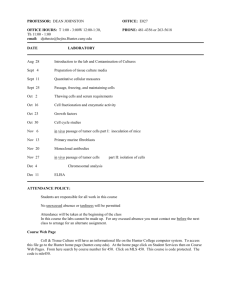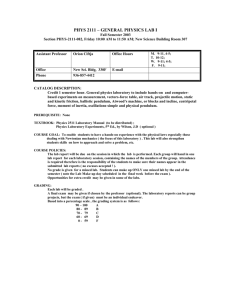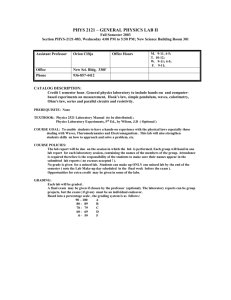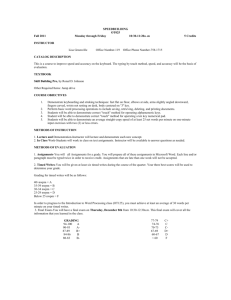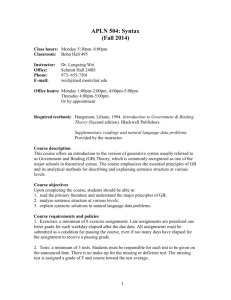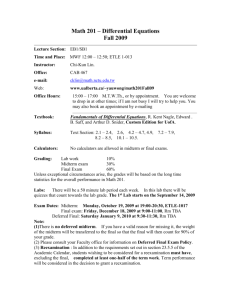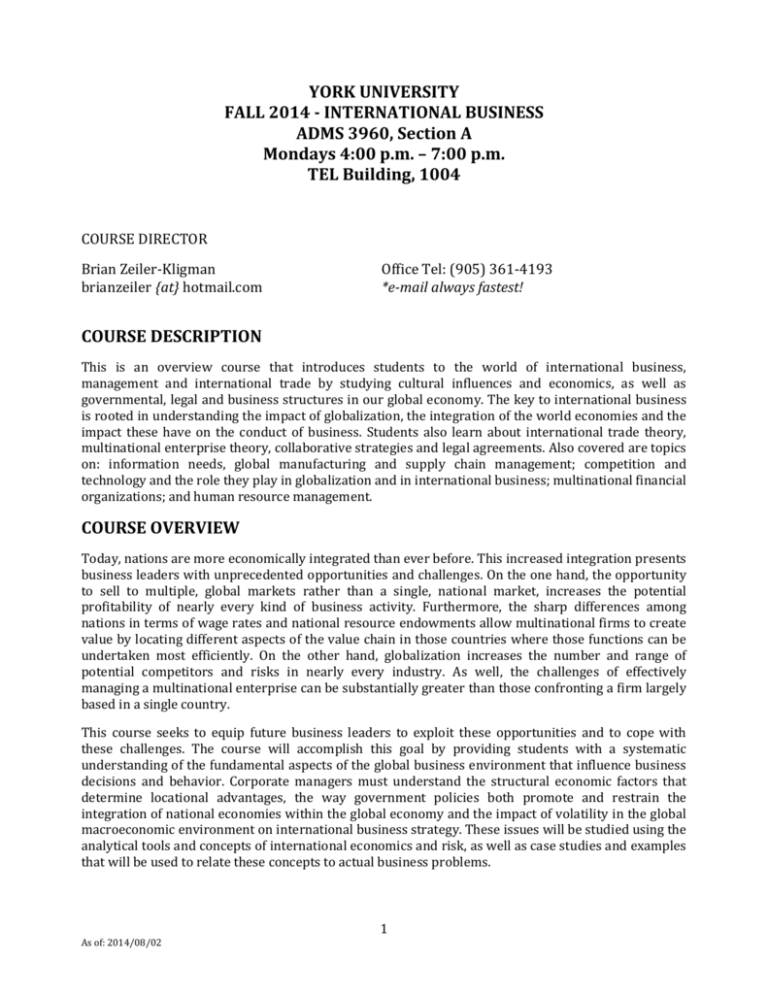
YORK UNIVERSITY
FALL 2014 - INTERNATIONAL BUSINESS
ADMS 3960, Section A
Mondays 4:00 p.m. – 7:00 p.m.
TEL Building, 1004
COURSE DIRECTOR
Brian Zeiler-Kligman
brianzeiler {at} hotmail.com
Office Tel: (905) 361-4193
*e-mail always fastest!
COURSE DESCRIPTION
This is an overview course that introduces students to the world of international business,
management and international trade by studying cultural influences and economics, as well as
governmental, legal and business structures in our global economy. The key to international business
is rooted in understanding the impact of globalization, the integration of the world economies and the
impact these have on the conduct of business. Students also learn about international trade theory,
multinational enterprise theory, collaborative strategies and legal agreements. Also covered are topics
on: information needs, global manufacturing and supply chain management; competition and
technology and the role they play in globalization and in international business; multinational financial
organizations; and human resource management.
COURSE OVERVIEW
Today, nations are more economically integrated than ever before. This increased integration presents
business leaders with unprecedented opportunities and challenges. On the one hand, the opportunity
to sell to multiple, global markets rather than a single, national market, increases the potential
profitability of nearly every kind of business activity. Furthermore, the sharp differences among
nations in terms of wage rates and national resource endowments allow multinational firms to create
value by locating different aspects of the value chain in those countries where those functions can be
undertaken most efficiently. On the other hand, globalization increases the number and range of
potential competitors and risks in nearly every industry. As well, the challenges of effectively
managing a multinational enterprise can be substantially greater than those confronting a firm largely
based in a single country.
This course seeks to equip future business leaders to exploit these opportunities and to cope with
these challenges. The course will accomplish this goal by providing students with a systematic
understanding of the fundamental aspects of the global business environment that influence business
decisions and behavior. Corporate managers must understand the structural economic factors that
determine locational advantages, the way government policies both promote and restrain the
integration of national economies within the global economy and the impact of volatility in the global
macroeconomic environment on international business strategy. These issues will be studied using the
analytical tools and concepts of international economics and risk, as well as case studies and examples
that will be used to relate these concepts to actual business problems.
1
As of: 2014/08/02
In addition to learning about strategic concepts, you can expect to further develop your abilities to size
up complex business situations, to identify the core problems and issues and to succinctly articulate
this analysis.
COURSE MATERIALS
Daniels, Radebaugh and Sullivan. International Business Environments and Operations, 15th ed. Pearson
Prentice Hall, 2014. NOTE: The 14th edition would be fine as well. See two different reading lists
below.
Course website, accessible via York University Moodle.
COURSE STYLE & FORMAT AND GENERAL COMMENTS
I make extensive use of Moodle and all class announcements will be posted there, so you should
regularly check the site for important communications.
I strongly believe in having interactive discussions rather than formal lectures. Class participation is
crucial both to your learning and our collective sanity, and is strongly related to the professionalism
component of your final grade for reasons described below.
I encourage relevant interruptions and questions at any point during any class, and I am available by email/phone regularly to address any questions or concerns that you may not want to raise in class.
COURSE ORGANIZATION AND READINGS
Please come to the first class with the required reading done. Also, have your name displayed in
large dark writing that I can see from the front of the room and bring that to every class.
*NOTE: Class schedule may be changed at the discretion of the Course Director.
The required reading list appears at the end of this document. NOTE: I have provided two versions –
one if you are using the fourteenth edition of the text book and the other if you are using the fifteenth
edition. Since the publisher has come out with a new (15th) edition, they are no longer making copies
of the 14th edition available. I believe, however, that the changes are not significant for our purposes,
and so I encourage you to try to find second-hand copies of the 14th edition to use. In the event that you
can’t or do not want to, reading lists reflecting both editions are provided.
COURSE EVALUATION
Mid-term test:
25%
Final exam:
30%
Group assignment: 35%
Professionalism* 10% *See below for further explanation/details.
Mid-term Exam (25%): A mid-term exam will be held during class on October 20, 2014. You must
attend the mid-term since there will be no other alternative dates to write a make-up exam. If you
miss the mid-term exam for a valid reason (as set-out in York policies), then the value of the mid-term
will be added to the value of your final exam, making your final exam worth 55%. If you do not have a
2
As of: 2014/08/02
valid reason for missing the mid-term exam, you will get a mark of zero. The mid-term exam is a
closed-book exam covering materials covered in class. You will be advised of the format in advance.
Final Exam (35%): The final exam will be held during the formal examination period. More details
will follow later, but the exam will be cumulative, covering all material from the semester.
Group Project (30%): This project has three components: a written paper, a presentation and peer
evaluation. A penalty of 5% for the first day, and 3% for each day thereafter (including each day of a
weekend or holiday) shall apply to all late assignments (i.e., paper, peer evaluations).
Group Formation: You are responsible for forming your own groups. Each group should have 6
members. Depending on final numbers enrolled in the course, some groups may only have 5 members.
A list of all members in your group, with each member’s full name, student number and e-mail address,
as well as your top 3 choices for the class presentation date (see below) and the topic you plan to
cover, must be submitted to me no later than September 22, 2014 (i.e. during the third lecture). You
should also include a very brief (50 words or less) overview of the specifics that you will cover. Shortly
thereafter, I will e-mail each group confirming the list of people in your group, as well as your topic
and date of presentation. I may have to allocate topics on a first-come, first-served basis if two
different groups wish to present on the same topic.
Paper & Presentation Topic: Your group will study a current International Business issue facing
organization(s) in Canada or elsewhere. There are multiple sources of information for this issue: the
news/press, journals, managers and employees, your own experiences, etc. Your group will write a
paper and present in class on this topic.
In our classes from October 22 through November 24 inclusive, 2 to 3 groups per class will submit
their group’s paper and present their presentation in class.
Written Paper
Your written paper should be between 10-12 pages, excluding the title page and list of references,
double-spaced, in 12-point font with 1” margins. An electronic copy must also be submitted through
the Moodle course website (as indicated on the website) by 7:00 p.m. on the day you present. You
will also need to submit a hard copy of the written paper on your presentation date. Only one copy of
the report for the entire group needs to be uploaded through Moodle. Every group member also
must complete, sign and date the “Academic Integrity Checklist” which is available on Moodle.
You should cover at least the following in the paper:
An introduction (i.e., the significance of the topic/issue, etc.)
A literature review, including what it is and what is known about it
Recommendations for organization(s) on how to manage the issue.
Your paper will be judged on style (grammar, etc.) and content (the extent and quality of your
research, analysis, and recommendations). (See the complete marking criteria below.) References
should be cited in MLA style.
You must include at least five (5) references on your References list. Three (3) of these five
references must be from peer-reviewed, academic journals or edited academic books. The other two
references may come from management or business trade magazines. Journal articles and book
chapters on your topic can be found by searching the York University Libraries
3
As of: 2014/08/02
It is strongly recommended that your group write your paper first and develop your presentation
second.
Presentation
The presentation should summarize the paper but do not read your paper in class. Not all members of
your group are required to participate in the presentation. The presentation will be limited to 12
minutes with an additional 3-5 minutes for questions and answers. You will be penalized for going
beyond these time limits.
The purpose of the presentation is to help develop your presentation skills. Things such as content,
structure, clarity, eye contact, audibility, effective use of presentation aids, and interaction with and
involvement of the class will form part of your grade.
Peer Evaluations
Each student must submit peer evaluations of their other group members which should not exceed 2
pages in length. The purpose of these evaluations is to ensure that each member is making consistent
and valuable contributions to the group assignment. You should evaluate each member with respect to
participation in group activities, both inside and outside of class. Carefully evaluate each team
member’s behaviour during activities with your group. These are CONFIDENTIAL evaluations. You
should not hesitate to provide negative feedback if it is warranted. If group members collude and agree
to provide only positive feedback, then each member will receive the same mark. In other words, you
can be negatively affected by the poor performance of your group members unless the collective
feedback suggests that marks should not be equal for all group members. There is no standard form to
be used, but instead, please comment on each group member in relation to the following:
His/her contribution and the timeliness of the contribution;
How well each person worked in the team;
Leadership;
Whether the person deserves to get the mark assigned to the project as a whole (or a
higher grade or a lower grade) and an explanation
Any comments on the assignment and suggestions, if any, to improve.
The peer evaluation survey must be typed and handed-in at the time of your presentation or you will
receive a mark of 0. Late peer evaluation survey responses will not be accepted.
Avoiding responsibility within groups is a form of academic dishonesty. Students that are reported by
other group members as avoiding their responsibilities may be investigated in order to determine, if
necessary, the appropriate academic penalties.
4
As of: 2014/08/02
Criteria for Evaluation for Group Project
The criteria set out below are specific to the written paper. However, they are reflective of the
evaluation criteria that will be used for the presentation as well (i.e. 20% of mark for presentation
format and style, 80% for content).
1. Format and Writing Style (20 points)
Overall presentation; Section Headings; Graphs, Tables and Illustrations; Footnotes;
Bibliography; Appendices; Other; Sentence structure; Word choice; Flow of paper
(including how fluid and seamless the various writing styles are); Vocabulary;
Punctuation; Spelling
2. Content (80 points)
Topic clearly defined; Directed at target audience; Arguments clearly presented;
Originality of thinking; Thoroughness of research; Thoroughness of response; Quality of
evidence; Coherence; Overall persuasiveness
Marks for Professionalism vs. Participation
The decision to base part of the course mark on professionalism is based, in part, on teaching
experience, through which I found there to be a direct correlation between students’ marks and their
level of participation in class discussions.
However, in considering this further, I decided that mere participation is insufficient, but in fact, it is
professionalism (which includes participation, among other things) that should be considered. It is my
hope that in basing a material portion of your final mark on professionalism, this will better prepare
you for the “real world”.
Practically-speaking, some of the things that will count towards this component of your final grade
include (but are not limited to) the following:
Attending class and being on time
Having your name clearly displayed in a large, dark font so I can read it from the front of the
room
Paying attention in-class, not using BlackBerrys, iPhones or other electronic devices
Being prepared for class, having done all of the assigned readings, and being prepared to speak
when called upon, often randomly
Participating in class discussions with meaningful contributions
Asking pertinent questions
Carefully following all instructions relating to classes, assignments and exams
Handing-in your work on-time (or early)
Respecting other students
This is not a kindergarten class and it is not my intent to “police” you. However, professionalism is
extremely important in the real world, and what better training than to begin now! To be clear, you
will not fail this course by missing classes, but if you regularly miss class with no valid reason, this will
certainly impact your professionalism mark, the same way regularly missing work with no valid
reason would certainly impact your career.
5
As of: 2014/08/02
SEE THE FOLLOWING TWO PAGES FOR THE REQUIRED
READINGS. ONE APPLIES IF YOU ARE USING THE
FOURTEENTH EDITION (WHICH I RECOMMEND) AND
ONE APPLIES IF YOU ARE USING THE FIFTEENTH
EDITION.
6
As of: 2014/08/02
FOURTEENTH EDITION – READING LIST
DATE
MAIN TOPICS
READINGS IN TEXT
1
Sept.8, 2014
Course overview, history and trends; the
meaning and impact of globalization; the
important role of change; why enter the
international marketplace
Ch. 1
2
Sept.15, 2014
Theories of international economics and
trade; why trade occurs
Ch. 6 (only pp. 219-232) and 7
3
Sept.22, 2014
4
Sept.29, 2014
The global trading system; key features;
economic integration (WTO, NAFTA, EU,
etc.); government influence on trade and trade
patterns; types of trade barriers
Foreign Direct Investment (FDI); motives,
patterns and government influence on FDI;
Rule of law and its importance in
international business; Corruption, ethics and
CSR
Oct. 6, 2014
Multinational enterprises; why go
international and ways to do it; forms of
ownership and alliances
Ch. 12 (only pp.440-452 and
458-460 and 464-468) and Ch.
14
Oct. 13, 2014
NO CLASS
Thanksgiving
Oct. 20, 2014
MID-TERM EXAM *WRITTEN INCLASS.
EXAM
Oct. 27, 2014
International monetary systems and
international financial institutions; foreign
exchange, exchange rates and inflation;
balance of payments; impact of recent global
recession and debt crisis
Ch. 4 (only pp. 153-176); and
Ch. 9 (but exclude pp.342-345
and pp.348-355) ; and Ch. 10
(exclude pp. 369-372)
Nov. 3, 2014
Role of competition, technology and
globalization in international business;
innovation and productivity; reasons for
opposition to globalization
Ch. 11 (exclude pp. 409-420)
Risk (cultural, political, economic, etc.);
culture and its impact on business; identifying
and managing risk
Ch. 2 and Ch. 3 (only pp.91118); and Ch. 12 (only pp.452457)
Marketing
Ch. 16
11
Nov. 24,
2014
Management in a MNE; supply chain
management; logistics; control of operations;
Human Resources Management
Ch. 11 (only pp. 409-419); and
Ch. 15 (only pp. 560-568 and pp.
574-585); and Ch. 17; and Ch. 20
(only pp. 761-778)
12
Dec. 1, 2014
IB in Action / REVIEW
NONE
5
6
7
8
9
10
Nov. 10,
2014
Nov. 17,
2014
7
As of: 2014/08/02
Ch. 3 (only pp.88-91 and 119124) and Ch. 8 (only pp. 290306); and Ch. 13
Ch. 5 and Ch. 14 (only pp.520528)
FIFTEENTH EDITION – READING LIST
DATE
MAIN TOPICS
READINGS IN TEXT
1
Sept.8, 2014
Course overview, history and trends; the
meaning and impact of globalization; the
important role of change; why enter the
international marketplace
Ch. 1
2
Sept.15, 2014
Theories of international economics and
trade; why trade occurs
Ch. 5 (only pp. 191-206) and 6
3
Sept.22, 2014
4
Sept.29, 2014
The global trading system; key features;
economic integration (WTO, NAFTA, EU,
etc.); government influence on trade and trade
patterns; types of trade barriers
Foreign Direct Investment (FDI); motives,
patterns and government influence on FDI;
Rule of law and its importance in
international business; Corruption, ethics and
CSR
Oct. 6, 2014
Multinational enterprises; why go
international and ways to do it; forms of
ownership and alliances
Ch. 13 (only pp.483-494 and
501-503 and 507-510) and Ch.
15
Oct. 13, 2014
NO CLASS
Thanksgiving
Oct. 20, 2014
MID-TERM EXAM *WRITTEN INCLASS.
EXAM
Oct. 27, 2014
International monetary systems and
international financial institutions; foreign
exchange, exchange rates and inflation;
balance of payments; impact of recent global
recession and debt crisis
Ch. 4 (only pp. 157-173); and
Ch. 8 (but exclude pp.mid-312 to
mid 314 and pp.317-328) ; and
Ch. 9 (exclude pp. bottom 339 to
mid 343)
Nov. 3, 2014
Role of competition, technology and
globalization in international business;
innovation and productivity; reasons for
opposition to globalization
Ch. 12 (exclude pp. 445 to mid
461)
Risk (cultural, political, economic, etc.);
culture and its impact on business; identifying
and managing risk
Ch. 2 and Ch. 3 (only pp.91121); and Ch. 13 (only pp.495 to
mid 501)
Marketing
Ch. 17
Ch. 12 (only pp. 445-455); and
Ch. 16 (only pp. 615-623 and pp.
630-643); and Ch. 18; and Ch. 20
(only pp. 769-787)
NONE
5
6
7
8
9
10
Nov. 10,
2014
Nov. 17,
2014
11
Nov. 24,
2014
Management in a MNE; supply chain
management; logistics; control of operations;
Human Resources Management
12
Dec. 1, 2014
IB in Action / REVIEW
8
As of: 2014/08/02
Ch. 3 (only pp.88-91 and 121129) and Ch. 7 (only pp. 262278); and Ch. 14
Ch. 11 and Ch. 15 (only pp.570581)


